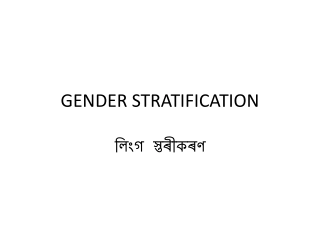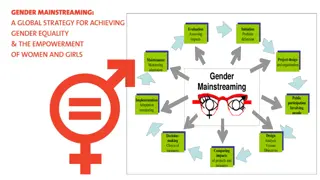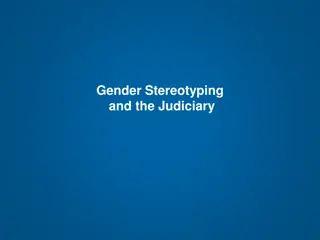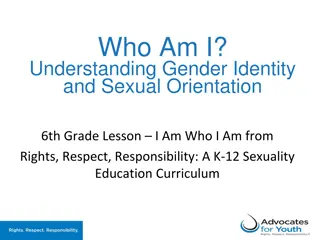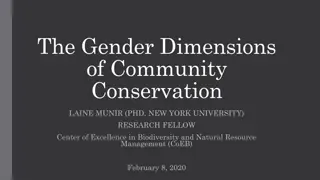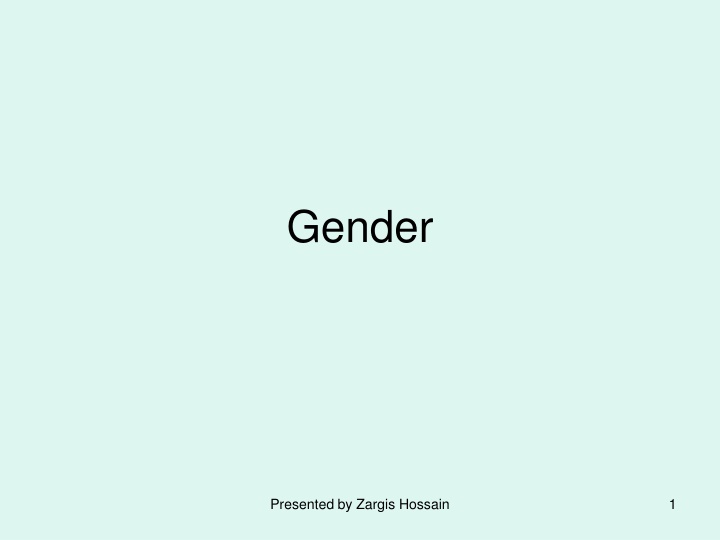
Gender: Social Constructs and Inequality
Explore the social construction of gender, the distinction between sex and gender, gender inequality, sources of gender differences, and sociological perspectives on gender stratification. Learn about the impact of cultural norms and biological differences on gender roles and identities.
Download Presentation

Please find below an Image/Link to download the presentation.
The content on the website is provided AS IS for your information and personal use only. It may not be sold, licensed, or shared on other websites without obtaining consent from the author. If you encounter any issues during the download, it is possible that the publisher has removed the file from their server.
You are allowed to download the files provided on this website for personal or commercial use, subject to the condition that they are used lawfully. All files are the property of their respective owners.
The content on the website is provided AS IS for your information and personal use only. It may not be sold, licensed, or shared on other websites without obtaining consent from the author.
E N D
Presentation Transcript
Gender Presented by Zargis Hossain 1
The Social Construction of Gender So-called natural differences have been used to justify unequal opportunity in education, employment, politics, and more Women were once thought incapable of succeeding at college because of their biological makeup Our cultural suppositions are more rooted in our social constructions of what is natural than in biological limitations 2 Gender
Sex and Gender Sex: biological differences between males and females Refers to who we are as males and females Gender: the social and cultural significance we attach to those presumed biological differences Refers to what we become as men and women, which occurs through socialization Gender 3
Gender and Inequality Gender stratification refers to the unequal distribution of wealth, power, and privilege between men and women. Men and women differ in their access to privilege, prestige, and power. Traditionally, men have been first in line when it comes to who gets what, when, and how. Sex is a biologically determined characteristic, while gender is a socially constructed characteristic. All societies use anatomical differences to assign gender roles. Gender identities are the conceptions we have of ourselves as being male or female. Sexism operates at both an individual and an institutional level. Gender 4
Sources of Gender Differences Gender roles can be seen as arising from biological development or cultural contributions. The biological aspects of gender consist of the physical differences between men and women. Gender roles probably represent the earliest division of labor among humans. Gender identities are the concepts we have of ourselves as being male or female. Theories of the acquisition of gender identities include the Freudian approach, cultural transmission, and cognitive development. Gender 5
The major sociological perspectives offer interpretation of gender stratification that resemble and parallel their positions on class and racial or ethnic stratification. Sociological Perspectives on Gender Stratification Functionalists suggest that families are organized along instrumental-expressive lines, with men specializing in instrumental tasks and women in expressive tasks. Conflict theorists contend that a sexual division of labor is a social vehicle devised by men to ensure themselves of privilege, prestige, and power in their relationships with women. Symbolic Interactionists argue that gender inequality persists because of the way we define men and women and their appropriate roles in society. Language helps perpetuate inequality. Feminists argue that women are disadvantaged because society is patriarchal. Gender 6
Gender Differences Across cultures Sex is considered as irrelevant to most areas of life in the Israeli kibbutzim, yet traditional gender roles seem to be reasserting themselves there. Margaret Mead studied gender in three New Guinea societies: Among the Arapesh, both sexes would be described by U.S. citizens as feminine. Among the Mundugumor, both sexes would be described by U.S. citizens as masculine. Among the Tchambuli, gender roles reverse U.S. standards. Mead concluded that these case studies prove that gender does vary across cultures. Critics charge that Mead oversimplified. Gender 7
In sum, what is considered to be female or male is mostly a creation of society. George Murdock surveyed over 200 societies and found substantial but not complete agreement concerning which tasks are feminine or masculine. Gender 8
Gender Roles in the United States Gender roles: expectations regarding proper behavior, attitudes, and activities of males and females Gender-Role Socialization Boys must be masculine: active, aggressive, tough, daring, and dominant Girls must be feminine: soft, emotional, sweet, and submissive Gender 9
Gender Roles in the United States Gender-Role Socialization Occurs through influences of parents, older siblings, mass media, religious and educational institutions, and other adults Prevalence of homophobia demonstrates how important clear line between masculinity and femininity is in our culture Gender 10
Gender Roles in the United States Women s Gender Roles 2004 Dove Campaign for Beauty found that only 2 percent of women around the world feel comfortable describing themselves as beautiful TV consistently portrays women as young, thin, and beautiful Children s books have portrayed most female characters as helpless, passive, and incompetent Gender 11
Satisfaction with Body Weight and Shape 12 Gender Source: Etcoff et al. 2004.
Gender Roles in the United States Men s Gender Roles Stay-at-home fathers still rare Must prove masculinity at work and in sports Nonconformists often face criticism and humiliation Multiple masculinities: idea that men learn and play a full range of gender roles Gender 13
Gender and Power Patriarchy is a form of social organization in which males dominate females. In general, women fare better in rich nations than in poor countries. Matriarchy is a form of social organization in which females dominate males. No matriarchal societies are known to exist or to have existed. Sexism is the belief that one sex is innately superior to the other. It underlies patriarchy and harms men, women, and the society as a whole. Patriarchy is not inevitable because modern technology has eliminated most of the historic justifications for it. Gender 14
Gender and Socialization. Gender roles are attitudes and activities that a culture links to each sex. Parents treat male and female children differently from birth. Peer groups reinforce these differences. Boys and girls play different kinds of games and learn different styles of moral reasoning from games. Curricula in schools further reinforce a culture s gender roles. The mass media, especially television, also serve this function. Gender 15
Gender and Social Stratification In industrial societies, women working for income is now the rule rather than the exception. Sixty-two percent of U.S. married couples depend on two incomes. Women continue to enter a narrow range of occupations almost half in clerical or service work. The greater a job s income and prestige, the more likely it is that the position will be held by a male. Working has not substantially reduced women s dominance in housework as men have failed to increase helping more at home. Gender 16
Gender and Inequality The average female full-time worker earns about 76 cents for every dollar earned by a male full-time employee. Most of this results from the different kinds of jobs held by men vs. women. The greater responsibility for family and childcare tasks that our society has traditionally assigned to women is another factor explaining the earning differential. Discrimination is a third critical factor. Our society still defines high-paying professions as masculine; this helps to explain why an equal number of women and men begin most professional graduate programs, but women are less likely to complete their degrees. Female involvement in politics is also increasing, although very slowly at the highest levels. As technology blurs the distinction between combat and noncombat personnel, women are taking on more military assignments, though equality has not yet been achieved. Gender 17
Gender and Inequality While women fit the definition of a minority group, most white women do not think of themselves this way. A minority is any category of people, distinguished by physical or cultural difference, that a society sets apart and subordinates. Minority women are doubly disadvantaged. This fact is at the heart of intersection theory, the investigation of the interplay of race, class, and gender; often resulting in multiple dimensions of disadvantage. Gender 18
Violence against women: Family violence is frequently directed against women. Female genital mutilation is practiced extensively in parts of Africa and the Middle East. Sexual harassment refers to comments, gestures, or physical contact of a sexual nature that is deliberate, repeated, and unwelcome. Women are more likely to be sexually harassed than are men. Some harassment is blatant but much of it is subtle. Feminists define pornography as a form of sexual violence against women, arguing that it demeans women and promotes rape. Gender 19
Theoretical Analysis of Gender. Structural-functional analysis suggests that traditional sex roles emerged in hunting and gathering societies where they promoted the efficient functioning of the family. Each sex played a role that complemented the role played by the other, with men taking the instrumental part and women the expressive. Talcott Parsons argues that gender role complementarity helps to integrate society; that girls and boys are socialized into expressive and instrumental roles respectively; and that social control reinforces gender-linked behavior. This view has been criticized as follows: It ignores the fact that many women have had to work outside the home due to necessity. It ignores the personal strains and social costs produced by rigid gender roles. It legitimizes the status quo. Gender 20
Social-conflict analysis explains contemporary sex roles in terms of dominance, subordination, and sexism. This perspective draws heavily on the work of Friedrich Engels, who felt that capitalism intensified male domination. This view has been criticized as follows: It casts conventional families as morally evil. It minimizes the extent to which people live happily in families. It argues, perhaps falsely, that capitalism stands at the root of gender stratification. Gender 21
Source: Curry et al Sociology For The Twenty-First Century, Fifth Edition, Pearson Education, Upper Saddle River,2008 Gender 22
Feminism. Feminism is the advocacy of social equality for the sexes in opposition to patriarchy and sexism. Basic feminist ideas: Working to increase equality. Expanding human choice. Eliminating gender stratification. Ending sexual violence. Promoting sexual freedom. Types of feminism: Liberal feminism. Socialist feminism. Radical feminism. Opposition to feminism. Opposition is primarily directed at its socialist and radical forms, while support for liberal feminism is widespread. There is a trend toward greater gender equality. Gender 23
Looking Ahead: Gender in the Twenty-first Century. While changes may be incremental, we are seeing movement toward a society in which women and men enjoy equal rights and opportunities. Gender 24

